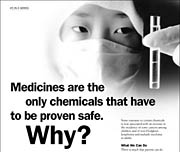|
子どもの健康と環境センター
Center for Children's Health and the Environment (CCHE) ニューヨーク・タイムズ紙掲載広告の科学的裏づけ文書 意見広告 5 内分泌かく乱化学物質は医薬品のように作用するが 医薬品のように規制されていない Scientific Background Paper for the "Endocrine-Disrupting Chemicals Act Like Drugs, But Are Not Regulated as Drugs" NY TIMES ad 5 http://www.childenvironment.org/pdfs/NYT%20Ads/6-00077%20FINAL_Toxics_MedChem_NYT.pdf 訳:安間 武 (化学物質問題市民研究会) 掲載日:2003年11月26日 このページへのリンク http://www.ne.jp/asahi/kagaku/pico/kodomo/cche/nyt_ad_5.html
内分泌かく乱化学物質は医薬品のように作用するが 医薬品のように規制されていない 新たな薬が市場に出される前に、アメリカ食品医薬品局(FDA)は詳細にわたる動物及び人間によるテストでその安全性と有効性を立証するよう求めている。大部分のアメリカ人は事前認可医薬品テストを支持している[1]。 避妊用ピルや閉経後ホルモン療法などのホルモン薬物もこのようにテストされ認可される。これらの薬物は体内で細胞の受容体に結びつき、体内の仕組みを変え、男女の性差決定、性的発育、及び、乳がんなどのホルモン依存性がんの危険性などに影響を与える。明らかに、このような深遠な効果を持つ薬物は、一般的用途として承認される前に、安全性が証明されなくてはならない。 しかし、このような承認された医薬品と同様なホルモン特性を持つ数千の化学物質が、事前承認安全性テストが全く行われることなく、世界中に広まっている。最近、アメリカ環境保護局は、年間製造量が100万ポンド(約454トン)を超える有機化学物質2,863種のデータを検証した。その調査の結果、これらの化学物質の43%は基本的毒性データが完全に欠落しており、完全な毒性データがあるのはわずか7%であることが分かった[2]。これらの化学物質のあるものは、FDA規制のホルモン薬物のように細胞受容体への結合作用を持っている。それらは、同等な、あるいは非常によく似たホルモン作用を示す。それらは我々の空気、水、土壌、食物に入り込んでおり、避けがたい[3]。それらは母乳をも汚染している[4]。そしてそれらは現在、地球上の魚類、爬虫類、鳥類、哺乳類、そして人間の体内組織に蓄積している[5]。我々がこれらの化学物質を ”医薬品” と呼ばないだけである。それらは、農薬、PCBs、ダイオキシン、その他産業化学物質として知られている。しかし、体内ではそれらはホルモン薬物と同じような作用をする。事実、これらを医薬品と区別できる唯一のことは、それらの表示と規制の方法だけであり、あっても最小限のものである。 これらのホルモン擬似作用化学物質は内分泌(ホルモン)系に影響を与えるので、 ”内分泌かく乱物質” と呼ばれている。過去20年間に集められた膨大な量の証拠は、内分泌かく乱物質が危険である、非常に危険であることを示している。 内分泌かく乱化学物質は様々な影響を与える。それらの多くは女性ホルモンのような作用があり、ホルモンバランスを女性側に傾ける[6]。以下のことを考えてみよう:
新たな医薬品は、安全であると証明されるまでは危険であると見なされる。しかし、内分泌かく乱産業化学物質は、危険であると証明されるまで、そして、数千人、数百万人の人々が曝露し莫大なダメージが起こるまで、安全であると見なされる。 最近使用されている内分泌かく乱物質の中で、半分より少ないものが潜在的な健康リスクに対するテストを実施しているが、それらの調査の多くは不適切であった[23]。 内分泌かく乱物質だけが動物や人間のホルモン系及び生殖系の異常発生増加の原因であろうか? 多分、それは違う。いくつかの研究がこれらの曝露と異常との間に関連性がないことを示している[24]。しかし、説得力のある証拠が内分泌かく乱物質を重要な容疑者として指し示している。 「後悔するより安全を」(Better safe than sorry)。不確実性は残るが、今や、内分泌かく乱物質の環境中への放散を制限するために果敢に運動することの正当性を示す十分な証拠があると我々は信じる。 これらの化学物質は医薬品のように作用する。これらの化学物質は医薬人同じような規制を受けなくてはならない。もし、それらが、実験室の動物、野生生物、又は人間に重大な内分泌かく乱作用を及ぼすのなら、それらは早急に、理想的には直ちに廃止されるべきである。 科学的裏づけ文書 [1] Blendon, D.J. et al. "Americans' Views on the Use and Regulation of Dietary Supplements," Archives of Internal Medicine (2001) 161:805-810. [2] EPA Office of Pollution Prevention and Toxics. "Chemical Hazard Data Availability Study: What Do We Really Know About the Safety of High-Production-Volume Chem\icals?" 1998. Washington, D.C. [3] Simonich, SL and RA Hites. Global distribution of persistent organochlorine compounds. Science (1995) 269:1851-1854. Wilkening, KE, LA Barrie and M Engle. Trans-Pacific Air Pollution. Science (2000) 290: 65-67. Blount, BC, MJ Silva, SP Caudill, LL Needham, JL Pirkle, EJ Sampson, GW Lucier, RJ Jackson, JW Brock. Levels of Seven Urinary Phthalate Metabolites in a Human Reference Population. Environmental Health Perspectives (2000) 108:979-982. [4] Laug, E.P. et al. "Occurrence of DDT in Human Fat and Milk." Archives of Industrial Hygiene and Occupational Medicine (1951) 3:245-2436. Rogan, W.J. et al. "Polychlorinated Biphenyls (PCBs) and Dichlorodiphenyl Dichloroethene (DDE) in Human Milk: Effects of Maternal Factors and Previous Lactation," Am. J. Public Health (1986) 76:172-177. DeWailly, E. et al. "Susceptibility to Infections and Immune Status in Inuit Infants Exposed to Organochlorines," Environ. Health Perspectives (2000) 108:205-211. Schecter, A. et al. "Dioxins in U.S. Food and Estimated Daily Intake," Chemosphere (1994) 29:2261-2265. Rogan, W.J. et al. "Pollutants in Breast Milk," New England J. Med. (1980) 302:1450-1453. Schreiber, J.S. "Predicted Infant Exposure to Tetrachloroethylene in Human Breast Milk," Risk Analysis (1993) 13:515-524. Quinsey, P.M. et al. "The Importance of Measured Intake in Assessing Exposure of Breast-Fed Infants to Organochlorines," European J. of Clinical Nutrition (1996) 50:438-442. [5] Colburn, T. et al. Our Stolen Future. (Plume, NY, 1997). [6] Raloff, J. Environmental Hormones: Threats to Health and Reproduction? Radio and Television News Directors Foundation, Washington, D.C. 1999. www.rtndf.org. [7] Guillette, L.J. et al. "Developmental Abnormalities of the Gonad and Abnormal Sex Hormone Concentrations in Juvenile Alligators from Contaminated and Control Lakes in Florida," Environmental Health Perspectives (1994) 102:680-688. [8] Fairchild, W.L. et al. "Does an Association Between Pesticide Use and Subsequent Declines in Catch of Atlantic Salmon (Salmo salar) Represent a Case of Endocrine Disruption?" Environmental Health Perspectives (1999) 107:349-358. Johnson, M.S. "Bioaccumulation of 2,4,6-Trinitrotoluene and PCBs Through Two Routes of Exposure in a Terrestrial Amphibian: Is the Dermal Route Significant?" Environmental Toxicology and Chemistry (1999) 18:873-878. Gronen, S. et al. "Serum Vitellogenin Levels and Reproductive Impairment of Male Japanese Medaka (Oryzias latipes) Exposed to 4-tert-octylphenol," Environmental Health Perspectives (1999) 107:385-390. Lye, C.M. et al. "Estrogenic Alkyphenols in Fish Tissues, Sediments, and Waters from the UK," Envvironmental Science and Toxicology (1999) 33:1009-1014. Lye, C.M. et al. "Seasonal Reproductive Health of Flounder (Platichthys flesus) Exposed to Sewage Effluent," Marine Ecology Progress Series (1998) 170:249-260. Jobling, S. et al. "Widespread Sexual Disruption in Wild Fish," Environmental Science and Technology (1998) 32:2498-2506. Jobling, S. et al. "Inhibition of Testicular Growth in Rainbow Trout (Oncorhynchus mykiss) Exposed to Estrogenic Alkyphenol Chemicals," Environmental Toxicology and Chemistry (1996) 15:194-202. [9] Sheehan, D.M. et al. "No Threshold Dose for Estradiol-Induced Sex Reversal of Turtle Embryos: How Little Is Too Much?" Environmental Health Perspectives (1999) 107:155. [10] Carlsen, E. et al. "Evidence for Decreasing Quality of Semen During the Past 50 Years," British Medical Journal (1992) 305:609-613. Swan, S.H. et al. "The Question of Declining Sperm Density Revisited: An Analysis of 101 Studies Published 1934-1996," Environmental Health Perspectives (2000) 108:961-966. [11] Swan, S.H. and E.P. Elkin. "Declining Semen Quality: Can the Past Inform the Present?" BioEssays (1999) 21:614-621. [12] Swan, S.H. et al. "Have Sperm Densities Declined? A Reanalysis of global Trend Data," Environmental Health Perspectives (1997) 105:1288-1232. [13] Gray, L.E. et al. "Environmental Antiandrogens: Low Doses of the Fungicide, Vinclozolin, Alter Sexual Differentiation of the Male Rat," Toxicology and Industrial Health. (1999) 15:48-64. [14] Guo, Y.L. et al. "Semen Quality After Prenatal Exposure to PCBs and Dibenzofurans," Lancet (2000) 356: 1240-1241. [15] Paulozzi, L.J. et al. "Hypospadias Trends in Two U.S. Surveillance Systems," Pediatrics (1997) 100:831-834. [16] Paulozzi, L.J. "International Trends in Rates of Hypospadias and Cryptorchidism," Environmental Health Perspectives (1999) 107:297-302. [17] Gray, L.E. et al. "Administration of Potentially Antiandrogenic Pesticides and Toxic Substances During Sexual Differentiation Produces Diverse Profiles of Reproductive Abnormalities in the Male Rat," Toxicology and Industrial Health (1999) 15:94-118. [18] Hussain N, Chaghtai A, Herndon CD, Herson VC, Rosenkrantz TS, McKenna PH. Hypospadias and early gestation growth restriction in infants. Pediatrics 109(3):473-8 (2002). [19] Mocarelli, P. et al. "Paternal Concentrations of Dioxin and Sex Ratio of Offspring," Lancet (2000) 355:1858-1863. [20] Davis, D.L. et al. "Reduced Ratio of Male to Female births in Several Industrialized Countries: A Sentinel Health Indicator?" J. of the Am. Med. Assoc. (1998) 279:1018-1023. [21] DeWailly, E. et al. "Susceptibility to Infections and Immune Status in Inuit Infants Exposed to Organochlorines," Environ. Health Perspectives (2000) 108:205-211. [22] Weisglas-Kuperus, N. et al. "Immunolgic Effects of Background Exposure to Polychlorinated Biphenyls and Dioxin in Dutch Preschool Children," Environ. Health Perspectives (2000) 108:1203-1207. [23] EPA Office of Pollution Prevention and Toxics. "Chemical Hazard Data Availability Study: What Do We Really Know About the Safety of High-Production-Volume Chem\icals?" 1998. Washington, D.C. [24] Acacio, B.D. et al. "Evaluation of a Large Cohort of Men Presenting for a Screening Semen Analysis," Fertility and Sterility (2000) 73:595-597 |
